Principles of Business Report: Legal, Financial, and Marketing Aspects
VerifiedAdded on 2020/06/06
|11
|3251
|27
Report
AI Summary
This report delves into the core principles of business, encompassing office management, financial planning, and marketing strategies. It begins by outlining legal requirements for office facilities, emphasizing health and safety, and detailing typical services and establishing effective office management procedures. The report then explores financial aspects, explaining the importance of financial ability, consequences of financial management, and different financial terminologies, including budgeting uses. Furthermore, it examines marketing principles, sales processes, market research, brand values, and the relationship between sales and marketing. The report also covers the legal obligations of employers and employees concerning health and safety in the workplace, including accident and emergency procedures. Overall, the report provides a comprehensive overview of essential business concepts, offering insights into various operational and strategic aspects, including workflow management, resource allocation, and welfare facilities.
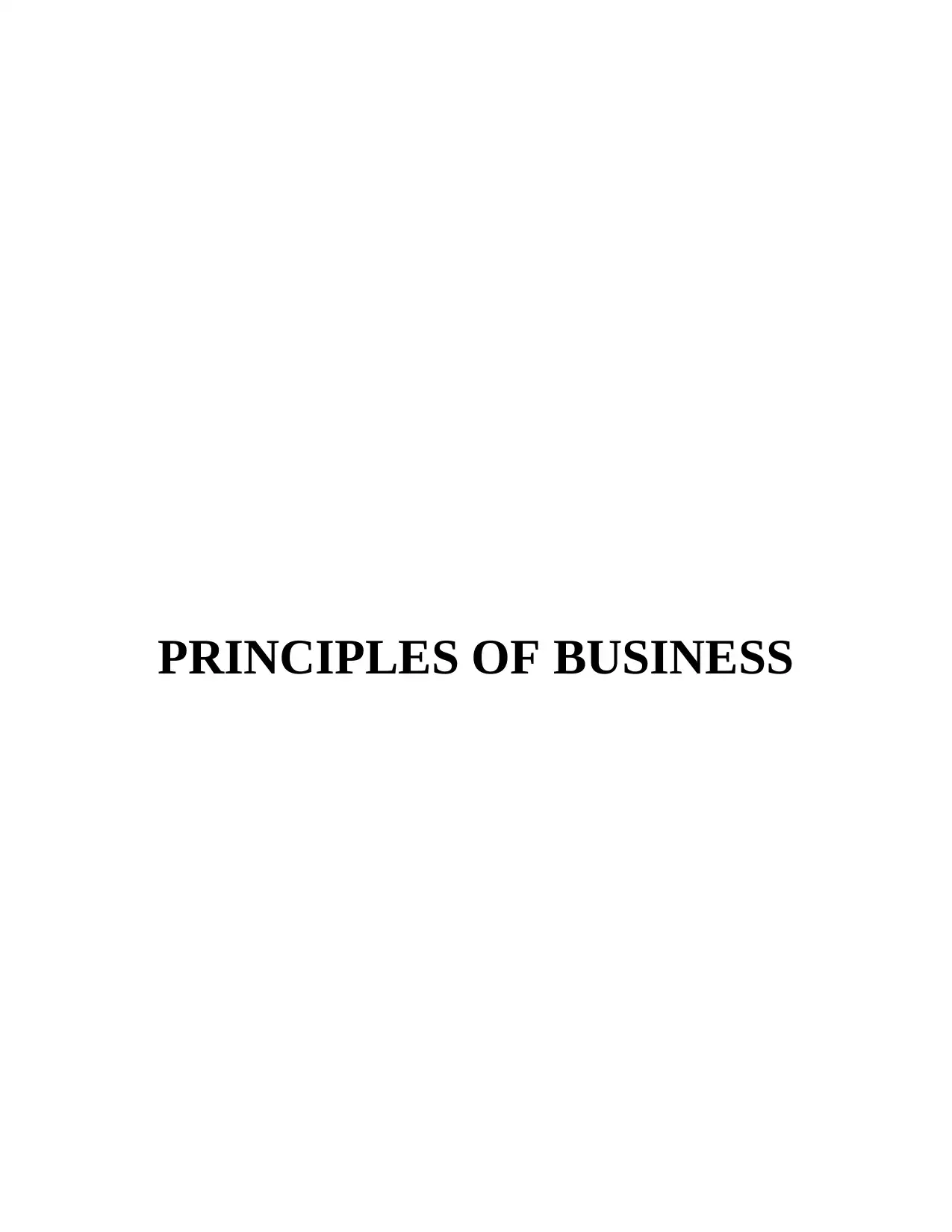
PRINCIPLES OF BUSINESS
Paraphrase This Document
Need a fresh take? Get an instant paraphrase of this document with our AI Paraphraser
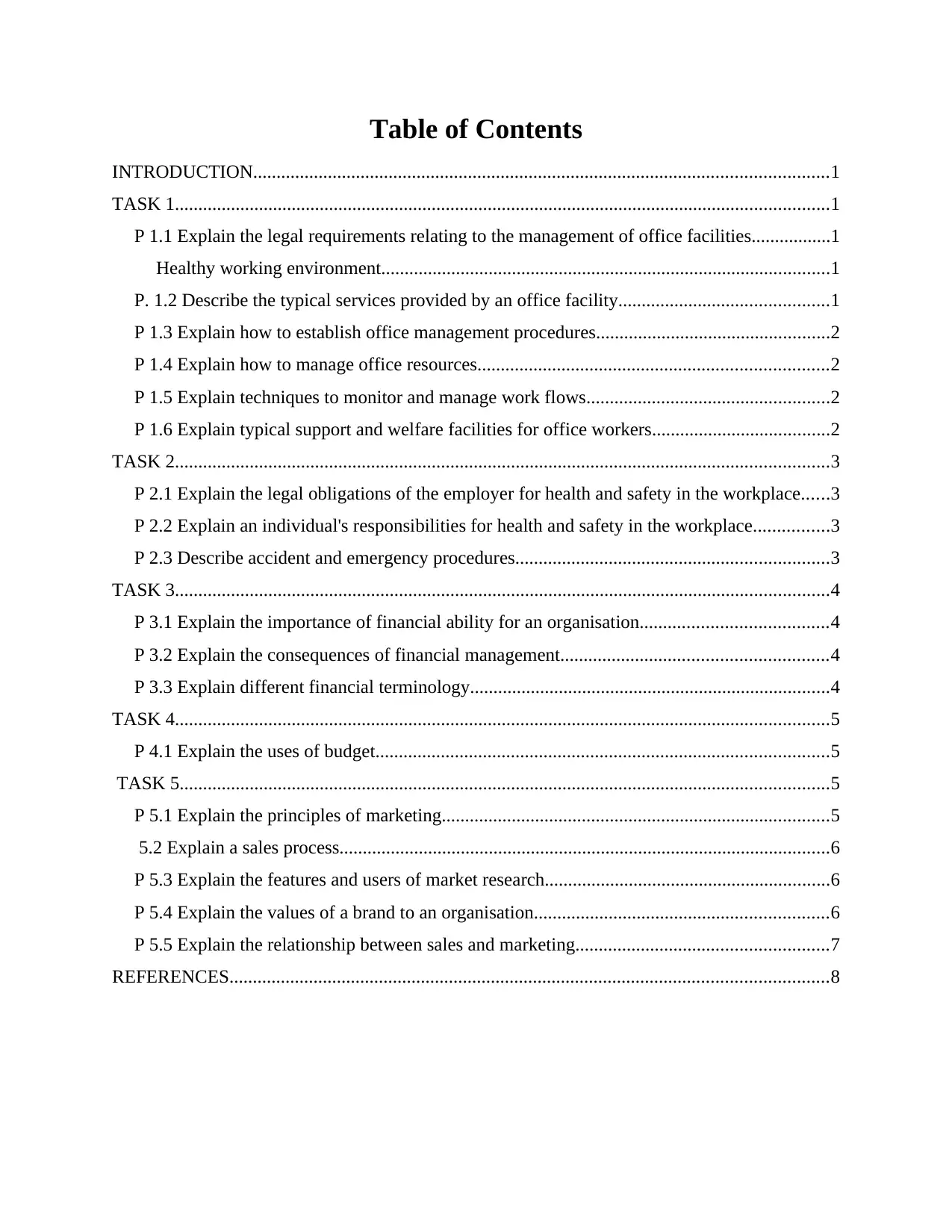
Table of Contents
INTRODUCTION...........................................................................................................................1
TASK 1............................................................................................................................................1
P 1.1 Explain the legal requirements relating to the management of office facilities.................1
Healthy working environment................................................................................................1
P. 1.2 Describe the typical services provided by an office facility.............................................1
P 1.3 Explain how to establish office management procedures..................................................2
P 1.4 Explain how to manage office resources...........................................................................2
P 1.5 Explain techniques to monitor and manage work flows....................................................2
P 1.6 Explain typical support and welfare facilities for office workers......................................2
TASK 2............................................................................................................................................3
P 2.1 Explain the legal obligations of the employer for health and safety in the workplace......3
P 2.2 Explain an individual's responsibilities for health and safety in the workplace................3
P 2.3 Describe accident and emergency procedures...................................................................3
TASK 3............................................................................................................................................4
P 3.1 Explain the importance of financial ability for an organisation........................................4
P 3.2 Explain the consequences of financial management.........................................................4
P 3.3 Explain different financial terminology.............................................................................4
TASK 4............................................................................................................................................5
P 4.1 Explain the uses of budget.................................................................................................5
TASK 5...........................................................................................................................................5
P 5.1 Explain the principles of marketing...................................................................................5
5.2 Explain a sales process.........................................................................................................6
P 5.3 Explain the features and users of market research.............................................................6
P 5.4 Explain the values of a brand to an organisation...............................................................6
P 5.5 Explain the relationship between sales and marketing......................................................7
REFERENCES................................................................................................................................8
INTRODUCTION...........................................................................................................................1
TASK 1............................................................................................................................................1
P 1.1 Explain the legal requirements relating to the management of office facilities.................1
Healthy working environment................................................................................................1
P. 1.2 Describe the typical services provided by an office facility.............................................1
P 1.3 Explain how to establish office management procedures..................................................2
P 1.4 Explain how to manage office resources...........................................................................2
P 1.5 Explain techniques to monitor and manage work flows....................................................2
P 1.6 Explain typical support and welfare facilities for office workers......................................2
TASK 2............................................................................................................................................3
P 2.1 Explain the legal obligations of the employer for health and safety in the workplace......3
P 2.2 Explain an individual's responsibilities for health and safety in the workplace................3
P 2.3 Describe accident and emergency procedures...................................................................3
TASK 3............................................................................................................................................4
P 3.1 Explain the importance of financial ability for an organisation........................................4
P 3.2 Explain the consequences of financial management.........................................................4
P 3.3 Explain different financial terminology.............................................................................4
TASK 4............................................................................................................................................5
P 4.1 Explain the uses of budget.................................................................................................5
TASK 5...........................................................................................................................................5
P 5.1 Explain the principles of marketing...................................................................................5
5.2 Explain a sales process.........................................................................................................6
P 5.3 Explain the features and users of market research.............................................................6
P 5.4 Explain the values of a brand to an organisation...............................................................6
P 5.5 Explain the relationship between sales and marketing......................................................7
REFERENCES................................................................................................................................8
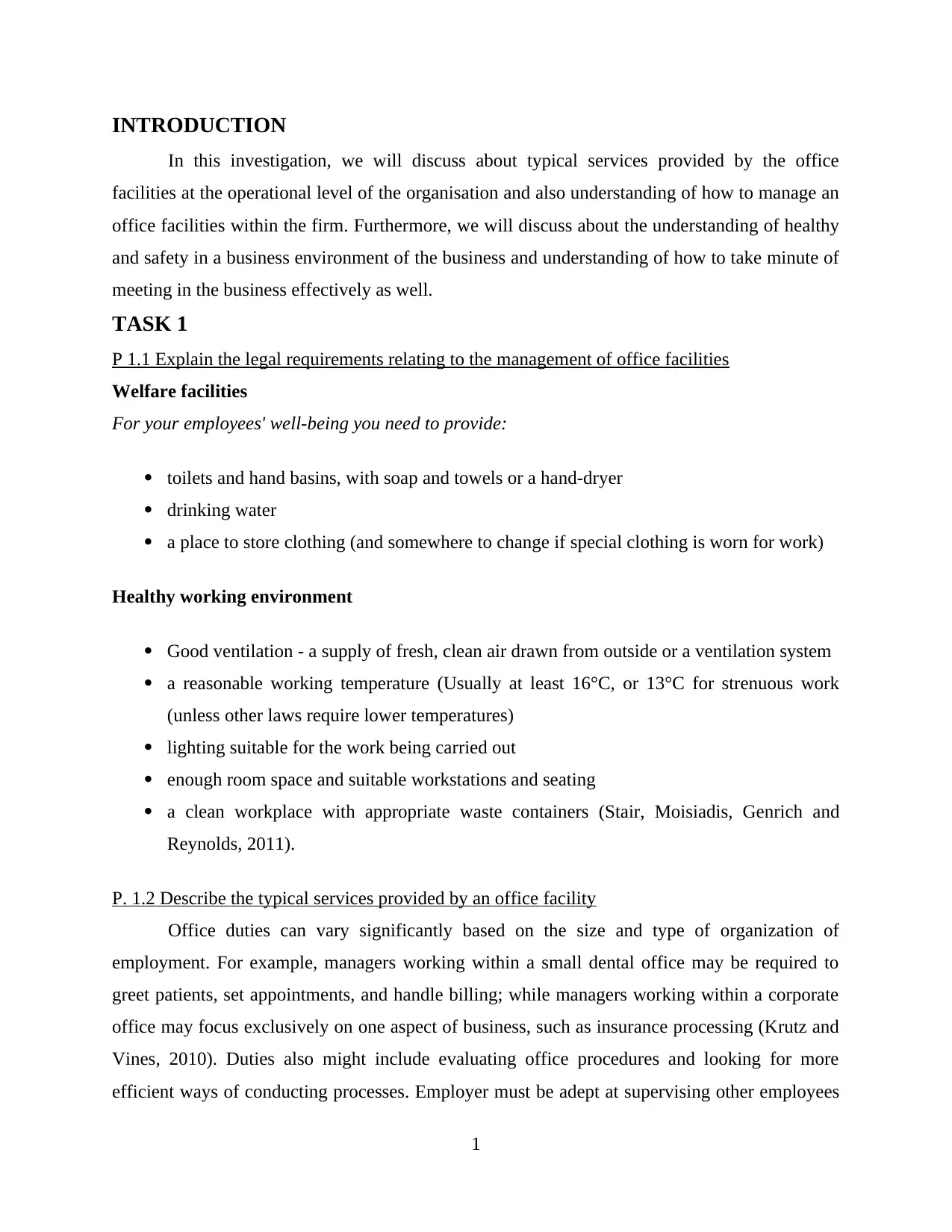
INTRODUCTION
In this investigation, we will discuss about typical services provided by the office
facilities at the operational level of the organisation and also understanding of how to manage an
office facilities within the firm. Furthermore, we will discuss about the understanding of healthy
and safety in a business environment of the business and understanding of how to take minute of
meeting in the business effectively as well.
TASK 1
P 1.1 Explain the legal requirements relating to the management of office facilities
Welfare facilities
For your employees' well-being you need to provide:
toilets and hand basins, with soap and towels or a hand-dryer
drinking water
a place to store clothing (and somewhere to change if special clothing is worn for work)
Healthy working environment
Good ventilation - a supply of fresh, clean air drawn from outside or a ventilation system
a reasonable working temperature (Usually at least 16°C, or 13°C for strenuous work
(unless other laws require lower temperatures)
lighting suitable for the work being carried out
enough room space and suitable workstations and seating
a clean workplace with appropriate waste containers (Stair, Moisiadis, Genrich and
Reynolds, 2011).
P. 1.2 Describe the typical services provided by an office facility
Office duties can vary significantly based on the size and type of organization of
employment. For example, managers working within a small dental office may be required to
greet patients, set appointments, and handle billing; while managers working within a corporate
office may focus exclusively on one aspect of business, such as insurance processing (Krutz and
Vines, 2010). Duties also might include evaluating office procedures and looking for more
efficient ways of conducting processes. Employer must be adept at supervising other employees
1
In this investigation, we will discuss about typical services provided by the office
facilities at the operational level of the organisation and also understanding of how to manage an
office facilities within the firm. Furthermore, we will discuss about the understanding of healthy
and safety in a business environment of the business and understanding of how to take minute of
meeting in the business effectively as well.
TASK 1
P 1.1 Explain the legal requirements relating to the management of office facilities
Welfare facilities
For your employees' well-being you need to provide:
toilets and hand basins, with soap and towels or a hand-dryer
drinking water
a place to store clothing (and somewhere to change if special clothing is worn for work)
Healthy working environment
Good ventilation - a supply of fresh, clean air drawn from outside or a ventilation system
a reasonable working temperature (Usually at least 16°C, or 13°C for strenuous work
(unless other laws require lower temperatures)
lighting suitable for the work being carried out
enough room space and suitable workstations and seating
a clean workplace with appropriate waste containers (Stair, Moisiadis, Genrich and
Reynolds, 2011).
P. 1.2 Describe the typical services provided by an office facility
Office duties can vary significantly based on the size and type of organization of
employment. For example, managers working within a small dental office may be required to
greet patients, set appointments, and handle billing; while managers working within a corporate
office may focus exclusively on one aspect of business, such as insurance processing (Krutz and
Vines, 2010). Duties also might include evaluating office procedures and looking for more
efficient ways of conducting processes. Employer must be adept at supervising other employees
1
⊘ This is a preview!⊘
Do you want full access?
Subscribe today to unlock all pages.

Trusted by 1+ million students worldwide
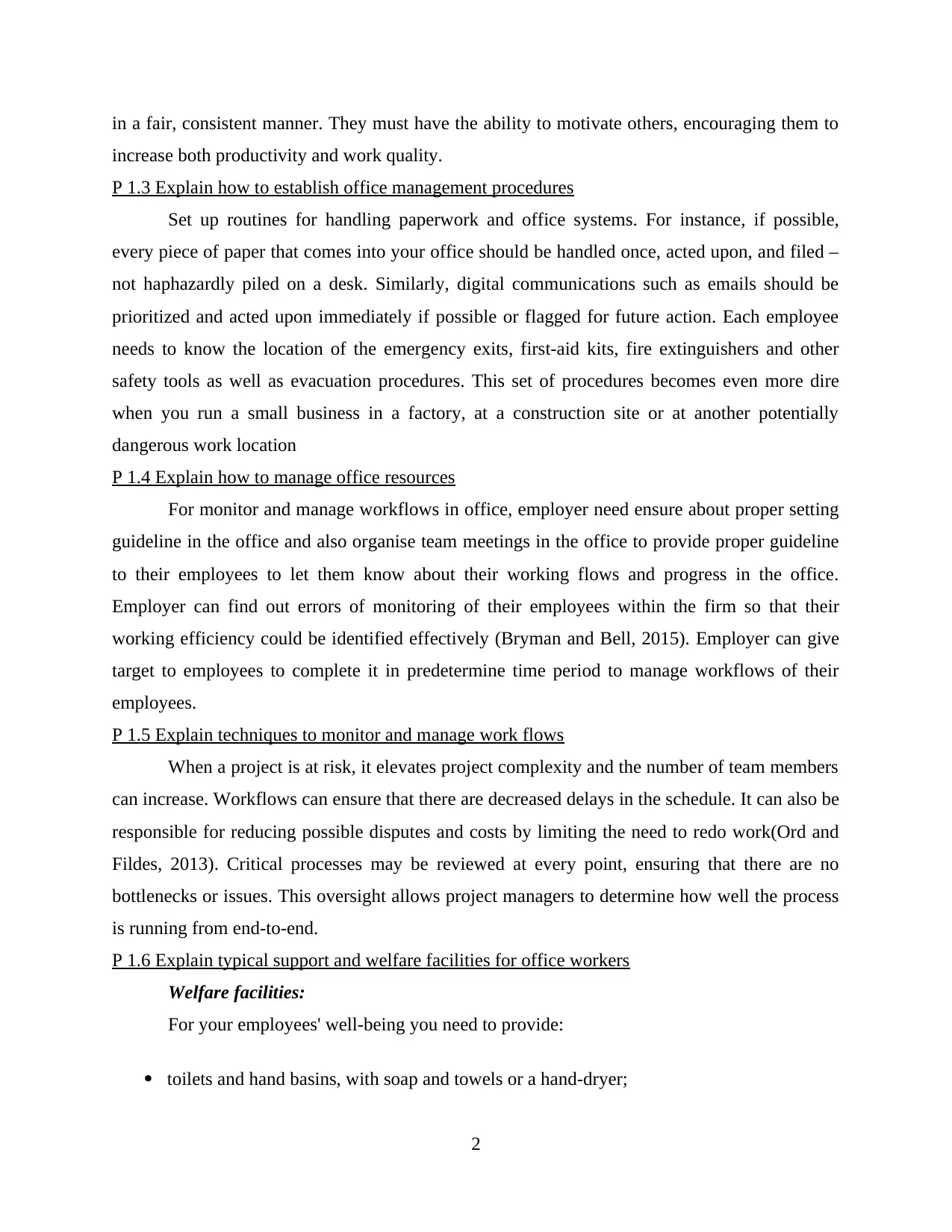
in a fair, consistent manner. They must have the ability to motivate others, encouraging them to
increase both productivity and work quality.
P 1.3 Explain how to establish office management procedures
Set up routines for handling paperwork and office systems. For instance, if possible,
every piece of paper that comes into your office should be handled once, acted upon, and filed –
not haphazardly piled on a desk. Similarly, digital communications such as emails should be
prioritized and acted upon immediately if possible or flagged for future action. Each employee
needs to know the location of the emergency exits, first-aid kits, fire extinguishers and other
safety tools as well as evacuation procedures. This set of procedures becomes even more dire
when you run a small business in a factory, at a construction site or at another potentially
dangerous work location
P 1.4 Explain how to manage office resources
For monitor and manage workflows in office, employer need ensure about proper setting
guideline in the office and also organise team meetings in the office to provide proper guideline
to their employees to let them know about their working flows and progress in the office.
Employer can find out errors of monitoring of their employees within the firm so that their
working efficiency could be identified effectively (Bryman and Bell, 2015). Employer can give
target to employees to complete it in predetermine time period to manage workflows of their
employees.
P 1.5 Explain techniques to monitor and manage work flows
When a project is at risk, it elevates project complexity and the number of team members
can increase. Workflows can ensure that there are decreased delays in the schedule. It can also be
responsible for reducing possible disputes and costs by limiting the need to redo work(Ord and
Fildes, 2013). Critical processes may be reviewed at every point, ensuring that there are no
bottlenecks or issues. This oversight allows project managers to determine how well the process
is running from end-to-end.
P 1.6 Explain typical support and welfare facilities for office workers
Welfare facilities:
For your employees' well-being you need to provide:
toilets and hand basins, with soap and towels or a hand-dryer;
2
increase both productivity and work quality.
P 1.3 Explain how to establish office management procedures
Set up routines for handling paperwork and office systems. For instance, if possible,
every piece of paper that comes into your office should be handled once, acted upon, and filed –
not haphazardly piled on a desk. Similarly, digital communications such as emails should be
prioritized and acted upon immediately if possible or flagged for future action. Each employee
needs to know the location of the emergency exits, first-aid kits, fire extinguishers and other
safety tools as well as evacuation procedures. This set of procedures becomes even more dire
when you run a small business in a factory, at a construction site or at another potentially
dangerous work location
P 1.4 Explain how to manage office resources
For monitor and manage workflows in office, employer need ensure about proper setting
guideline in the office and also organise team meetings in the office to provide proper guideline
to their employees to let them know about their working flows and progress in the office.
Employer can find out errors of monitoring of their employees within the firm so that their
working efficiency could be identified effectively (Bryman and Bell, 2015). Employer can give
target to employees to complete it in predetermine time period to manage workflows of their
employees.
P 1.5 Explain techniques to monitor and manage work flows
When a project is at risk, it elevates project complexity and the number of team members
can increase. Workflows can ensure that there are decreased delays in the schedule. It can also be
responsible for reducing possible disputes and costs by limiting the need to redo work(Ord and
Fildes, 2013). Critical processes may be reviewed at every point, ensuring that there are no
bottlenecks or issues. This oversight allows project managers to determine how well the process
is running from end-to-end.
P 1.6 Explain typical support and welfare facilities for office workers
Welfare facilities:
For your employees' well-being you need to provide:
toilets and hand basins, with soap and towels or a hand-dryer;
2
Paraphrase This Document
Need a fresh take? Get an instant paraphrase of this document with our AI Paraphraser
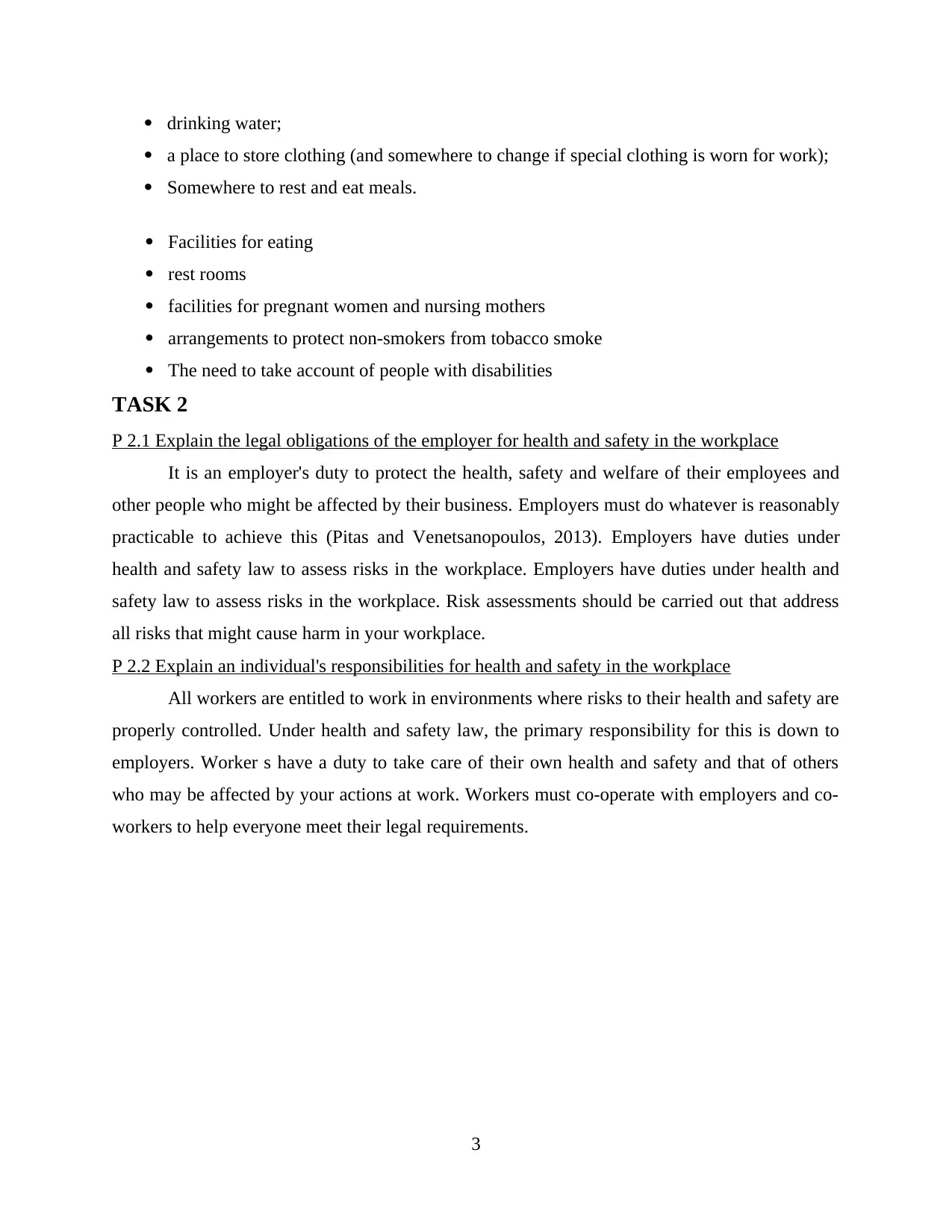
drinking water;
a place to store clothing (and somewhere to change if special clothing is worn for work);
Somewhere to rest and eat meals.
Facilities for eating
rest rooms
facilities for pregnant women and nursing mothers
arrangements to protect non-smokers from tobacco smoke
The need to take account of people with disabilities
TASK 2
P 2.1 Explain the legal obligations of the employer for health and safety in the workplace
It is an employer's duty to protect the health, safety and welfare of their employees and
other people who might be affected by their business. Employers must do whatever is reasonably
practicable to achieve this (Pitas and Venetsanopoulos, 2013). Employers have duties under
health and safety law to assess risks in the workplace. Employers have duties under health and
safety law to assess risks in the workplace. Risk assessments should be carried out that address
all risks that might cause harm in your workplace.
P 2.2 Explain an individual's responsibilities for health and safety in the workplace
All workers are entitled to work in environments where risks to their health and safety are
properly controlled. Under health and safety law, the primary responsibility for this is down to
employers. Worker s have a duty to take care of their own health and safety and that of others
who may be affected by your actions at work. Workers must co-operate with employers and co-
workers to help everyone meet their legal requirements.
3
a place to store clothing (and somewhere to change if special clothing is worn for work);
Somewhere to rest and eat meals.
Facilities for eating
rest rooms
facilities for pregnant women and nursing mothers
arrangements to protect non-smokers from tobacco smoke
The need to take account of people with disabilities
TASK 2
P 2.1 Explain the legal obligations of the employer for health and safety in the workplace
It is an employer's duty to protect the health, safety and welfare of their employees and
other people who might be affected by their business. Employers must do whatever is reasonably
practicable to achieve this (Pitas and Venetsanopoulos, 2013). Employers have duties under
health and safety law to assess risks in the workplace. Employers have duties under health and
safety law to assess risks in the workplace. Risk assessments should be carried out that address
all risks that might cause harm in your workplace.
P 2.2 Explain an individual's responsibilities for health and safety in the workplace
All workers are entitled to work in environments where risks to their health and safety are
properly controlled. Under health and safety law, the primary responsibility for this is down to
employers. Worker s have a duty to take care of their own health and safety and that of others
who may be affected by your actions at work. Workers must co-operate with employers and co-
workers to help everyone meet their legal requirements.
3
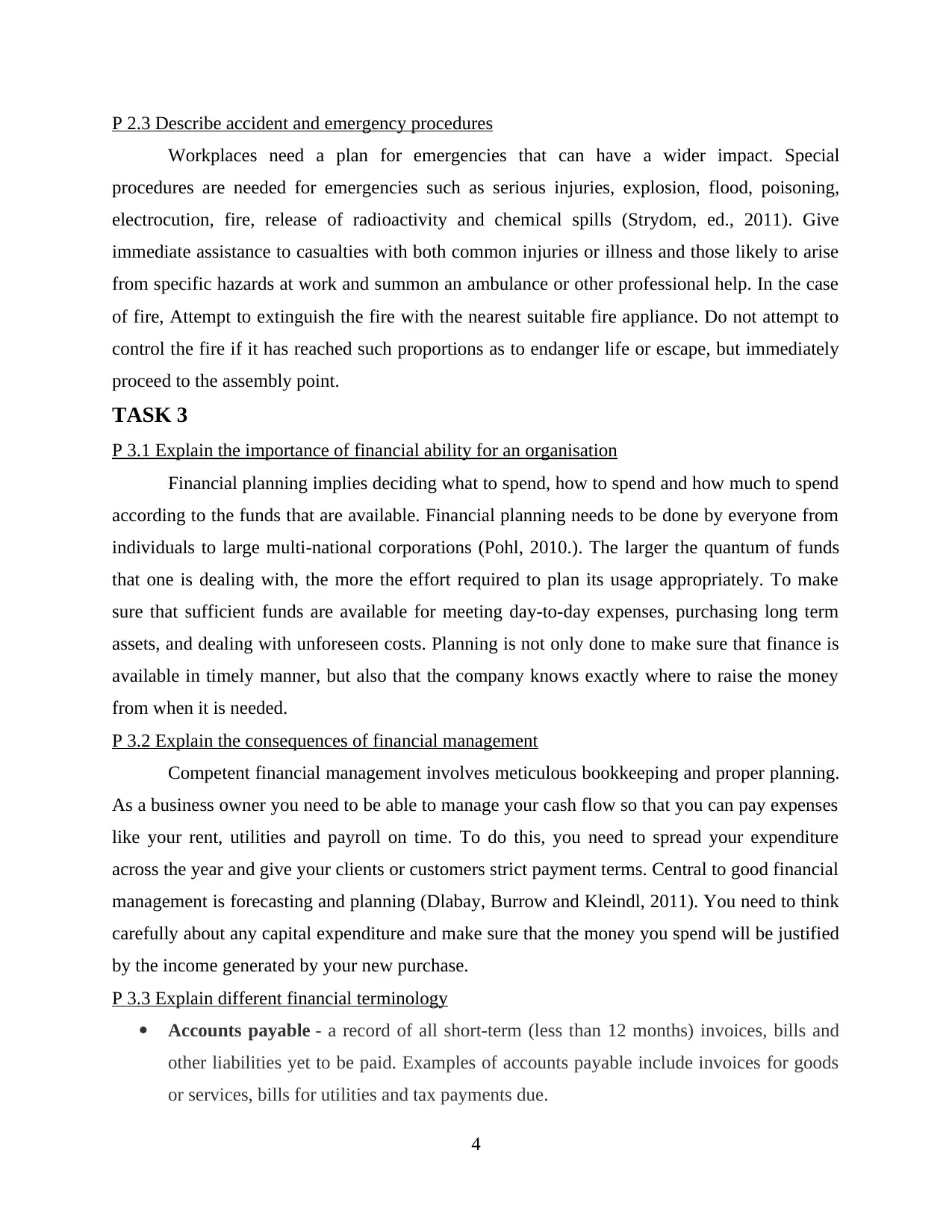
P 2.3 Describe accident and emergency procedures
Workplaces need a plan for emergencies that can have a wider impact. Special
procedures are needed for emergencies such as serious injuries, explosion, flood, poisoning,
electrocution, fire, release of radioactivity and chemical spills (Strydom, ed., 2011). Give
immediate assistance to casualties with both common injuries or illness and those likely to arise
from specific hazards at work and summon an ambulance or other professional help. In the case
of fire, Attempt to extinguish the fire with the nearest suitable fire appliance. Do not attempt to
control the fire if it has reached such proportions as to endanger life or escape, but immediately
proceed to the assembly point.
TASK 3
P 3.1 Explain the importance of financial ability for an organisation
Financial planning implies deciding what to spend, how to spend and how much to spend
according to the funds that are available. Financial planning needs to be done by everyone from
individuals to large multi-national corporations (Pohl, 2010.). The larger the quantum of funds
that one is dealing with, the more the effort required to plan its usage appropriately. To make
sure that sufficient funds are available for meeting day-to-day expenses, purchasing long term
assets, and dealing with unforeseen costs. Planning is not only done to make sure that finance is
available in timely manner, but also that the company knows exactly where to raise the money
from when it is needed.
P 3.2 Explain the consequences of financial management
Competent financial management involves meticulous bookkeeping and proper planning.
As a business owner you need to be able to manage your cash flow so that you can pay expenses
like your rent, utilities and payroll on time. To do this, you need to spread your expenditure
across the year and give your clients or customers strict payment terms. Central to good financial
management is forecasting and planning (Dlabay, Burrow and Kleindl, 2011). You need to think
carefully about any capital expenditure and make sure that the money you spend will be justified
by the income generated by your new purchase.
P 3.3 Explain different financial terminology
Accounts payable - a record of all short-term (less than 12 months) invoices, bills and
other liabilities yet to be paid. Examples of accounts payable include invoices for goods
or services, bills for utilities and tax payments due.
4
Workplaces need a plan for emergencies that can have a wider impact. Special
procedures are needed for emergencies such as serious injuries, explosion, flood, poisoning,
electrocution, fire, release of radioactivity and chemical spills (Strydom, ed., 2011). Give
immediate assistance to casualties with both common injuries or illness and those likely to arise
from specific hazards at work and summon an ambulance or other professional help. In the case
of fire, Attempt to extinguish the fire with the nearest suitable fire appliance. Do not attempt to
control the fire if it has reached such proportions as to endanger life or escape, but immediately
proceed to the assembly point.
TASK 3
P 3.1 Explain the importance of financial ability for an organisation
Financial planning implies deciding what to spend, how to spend and how much to spend
according to the funds that are available. Financial planning needs to be done by everyone from
individuals to large multi-national corporations (Pohl, 2010.). The larger the quantum of funds
that one is dealing with, the more the effort required to plan its usage appropriately. To make
sure that sufficient funds are available for meeting day-to-day expenses, purchasing long term
assets, and dealing with unforeseen costs. Planning is not only done to make sure that finance is
available in timely manner, but also that the company knows exactly where to raise the money
from when it is needed.
P 3.2 Explain the consequences of financial management
Competent financial management involves meticulous bookkeeping and proper planning.
As a business owner you need to be able to manage your cash flow so that you can pay expenses
like your rent, utilities and payroll on time. To do this, you need to spread your expenditure
across the year and give your clients or customers strict payment terms. Central to good financial
management is forecasting and planning (Dlabay, Burrow and Kleindl, 2011). You need to think
carefully about any capital expenditure and make sure that the money you spend will be justified
by the income generated by your new purchase.
P 3.3 Explain different financial terminology
Accounts payable - a record of all short-term (less than 12 months) invoices, bills and
other liabilities yet to be paid. Examples of accounts payable include invoices for goods
or services, bills for utilities and tax payments due.
4
⊘ This is a preview!⊘
Do you want full access?
Subscribe today to unlock all pages.

Trusted by 1+ million students worldwide
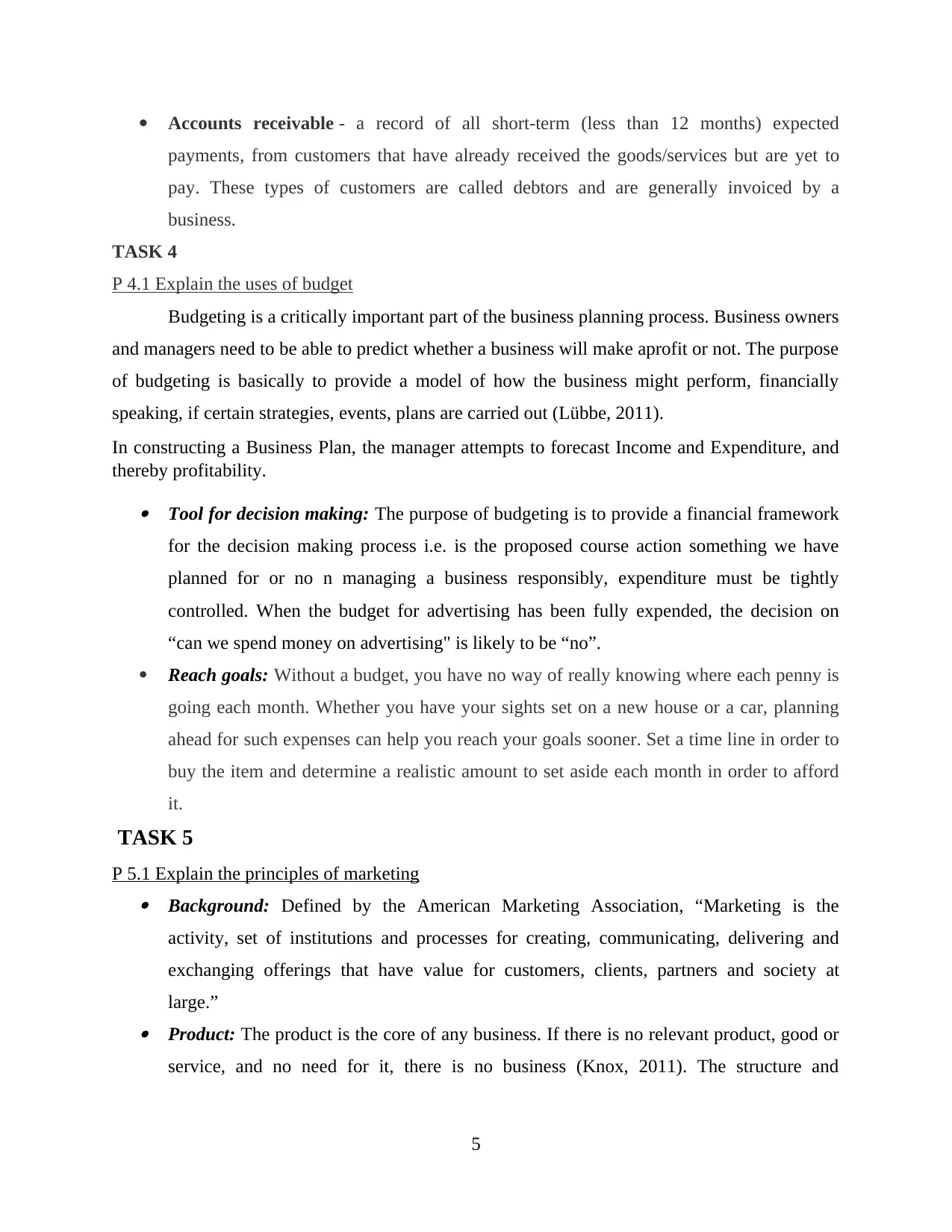
Accounts receivable - a record of all short-term (less than 12 months) expected
payments, from customers that have already received the goods/services but are yet to
pay. These types of customers are called debtors and are generally invoiced by a
business.
TASK 4
P 4.1 Explain the uses of budget
Budgeting is a critically important part of the business planning process. Business owners
and managers need to be able to predict whether a business will make aprofit or not. The purpose
of budgeting is basically to provide a model of how the business might perform, financially
speaking, if certain strategies, events, plans are carried out (Lübbe, 2011).
In constructing a Business Plan, the manager attempts to forecast Income and Expenditure, and
thereby profitability. Tool for decision making: The purpose of budgeting is to provide a financial framework
for the decision making process i.e. is the proposed course action something we have
planned for or no n managing a business responsibly, expenditure must be tightly
controlled. When the budget for advertising has been fully expended, the decision on
“can we spend money on advertising" is likely to be “no”.
Reach goals: Without a budget, you have no way of really knowing where each penny is
going each month. Whether you have your sights set on a new house or a car, planning
ahead for such expenses can help you reach your goals sooner. Set a time line in order to
buy the item and determine a realistic amount to set aside each month in order to afford
it.
TASK 5
P 5.1 Explain the principles of marketing Background: Defined by the American Marketing Association, “Marketing is the
activity, set of institutions and processes for creating, communicating, delivering and
exchanging offerings that have value for customers, clients, partners and society at
large.” Product: The product is the core of any business. If there is no relevant product, good or
service, and no need for it, there is no business (Knox, 2011). The structure and
5
payments, from customers that have already received the goods/services but are yet to
pay. These types of customers are called debtors and are generally invoiced by a
business.
TASK 4
P 4.1 Explain the uses of budget
Budgeting is a critically important part of the business planning process. Business owners
and managers need to be able to predict whether a business will make aprofit or not. The purpose
of budgeting is basically to provide a model of how the business might perform, financially
speaking, if certain strategies, events, plans are carried out (Lübbe, 2011).
In constructing a Business Plan, the manager attempts to forecast Income and Expenditure, and
thereby profitability. Tool for decision making: The purpose of budgeting is to provide a financial framework
for the decision making process i.e. is the proposed course action something we have
planned for or no n managing a business responsibly, expenditure must be tightly
controlled. When the budget for advertising has been fully expended, the decision on
“can we spend money on advertising" is likely to be “no”.
Reach goals: Without a budget, you have no way of really knowing where each penny is
going each month. Whether you have your sights set on a new house or a car, planning
ahead for such expenses can help you reach your goals sooner. Set a time line in order to
buy the item and determine a realistic amount to set aside each month in order to afford
it.
TASK 5
P 5.1 Explain the principles of marketing Background: Defined by the American Marketing Association, “Marketing is the
activity, set of institutions and processes for creating, communicating, delivering and
exchanging offerings that have value for customers, clients, partners and society at
large.” Product: The product is the core of any business. If there is no relevant product, good or
service, and no need for it, there is no business (Knox, 2011). The structure and
5
Paraphrase This Document
Need a fresh take? Get an instant paraphrase of this document with our AI Paraphraser
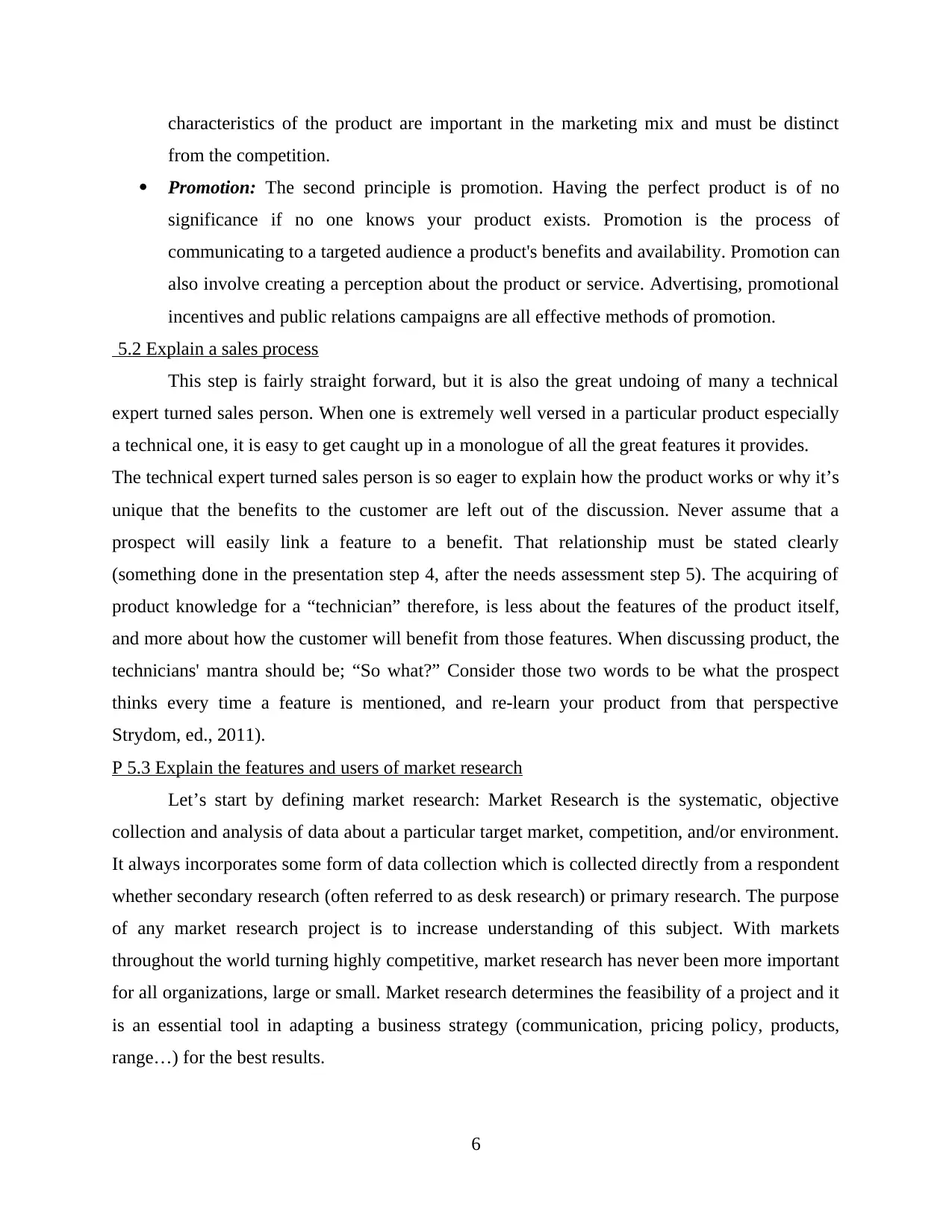
characteristics of the product are important in the marketing mix and must be distinct
from the competition.
Promotion: The second principle is promotion. Having the perfect product is of no
significance if no one knows your product exists. Promotion is the process of
communicating to a targeted audience a product's benefits and availability. Promotion can
also involve creating a perception about the product or service. Advertising, promotional
incentives and public relations campaigns are all effective methods of promotion.
5.2 Explain a sales process
This step is fairly straight forward, but it is also the great undoing of many a technical
expert turned sales person. When one is extremely well versed in a particular product especially
a technical one, it is easy to get caught up in a monologue of all the great features it provides.
The technical expert turned sales person is so eager to explain how the product works or why it’s
unique that the benefits to the customer are left out of the discussion. Never assume that a
prospect will easily link a feature to a benefit. That relationship must be stated clearly
(something done in the presentation step 4, after the needs assessment step 5). The acquiring of
product knowledge for a “technician” therefore, is less about the features of the product itself,
and more about how the customer will benefit from those features. When discussing product, the
technicians' mantra should be; “So what?” Consider those two words to be what the prospect
thinks every time a feature is mentioned, and re-learn your product from that perspective
Strydom, ed., 2011).
P 5.3 Explain the features and users of market research
Let’s start by defining market research: Market Research is the systematic, objective
collection and analysis of data about a particular target market, competition, and/or environment.
It always incorporates some form of data collection which is collected directly from a respondent
whether secondary research (often referred to as desk research) or primary research. The purpose
of any market research project is to increase understanding of this subject. With markets
throughout the world turning highly competitive, market research has never been more important
for all organizations, large or small. Market research determines the feasibility of a project and it
is an essential tool in adapting a business strategy (communication, pricing policy, products,
range…) for the best results.
6
from the competition.
Promotion: The second principle is promotion. Having the perfect product is of no
significance if no one knows your product exists. Promotion is the process of
communicating to a targeted audience a product's benefits and availability. Promotion can
also involve creating a perception about the product or service. Advertising, promotional
incentives and public relations campaigns are all effective methods of promotion.
5.2 Explain a sales process
This step is fairly straight forward, but it is also the great undoing of many a technical
expert turned sales person. When one is extremely well versed in a particular product especially
a technical one, it is easy to get caught up in a monologue of all the great features it provides.
The technical expert turned sales person is so eager to explain how the product works or why it’s
unique that the benefits to the customer are left out of the discussion. Never assume that a
prospect will easily link a feature to a benefit. That relationship must be stated clearly
(something done in the presentation step 4, after the needs assessment step 5). The acquiring of
product knowledge for a “technician” therefore, is less about the features of the product itself,
and more about how the customer will benefit from those features. When discussing product, the
technicians' mantra should be; “So what?” Consider those two words to be what the prospect
thinks every time a feature is mentioned, and re-learn your product from that perspective
Strydom, ed., 2011).
P 5.3 Explain the features and users of market research
Let’s start by defining market research: Market Research is the systematic, objective
collection and analysis of data about a particular target market, competition, and/or environment.
It always incorporates some form of data collection which is collected directly from a respondent
whether secondary research (often referred to as desk research) or primary research. The purpose
of any market research project is to increase understanding of this subject. With markets
throughout the world turning highly competitive, market research has never been more important
for all organizations, large or small. Market research determines the feasibility of a project and it
is an essential tool in adapting a business strategy (communication, pricing policy, products,
range…) for the best results.
6
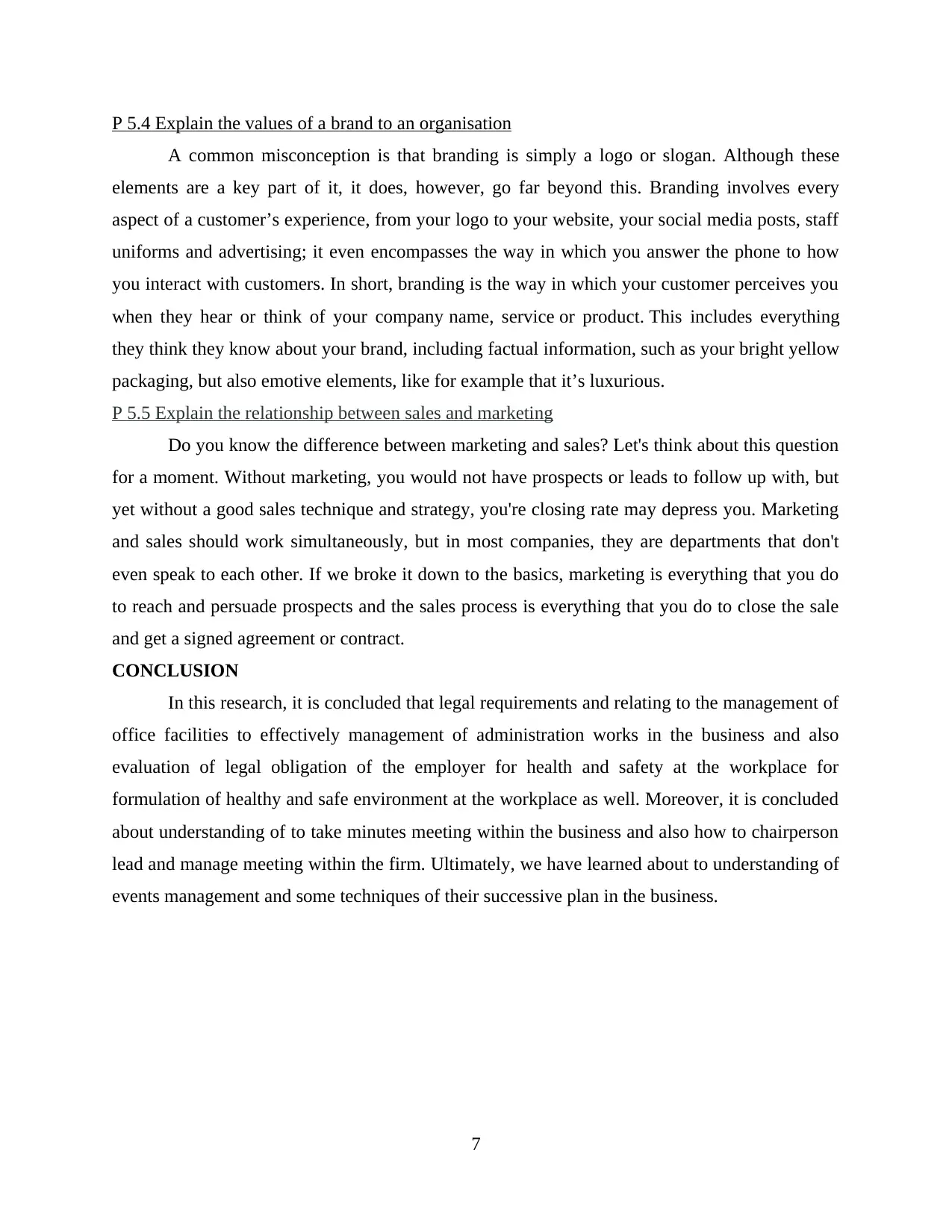
P 5.4 Explain the values of a brand to an organisation
A common misconception is that branding is simply a logo or slogan. Although these
elements are a key part of it, it does, however, go far beyond this. Branding involves every
aspect of a customer’s experience, from your logo to your website, your social media posts, staff
uniforms and advertising; it even encompasses the way in which you answer the phone to how
you interact with customers. In short, branding is the way in which your customer perceives you
when they hear or think of your company name, service or product. This includes everything
they think they know about your brand, including factual information, such as your bright yellow
packaging, but also emotive elements, like for example that it’s luxurious.
P 5.5 Explain the relationship between sales and marketing
Do you know the difference between marketing and sales? Let's think about this question
for a moment. Without marketing, you would not have prospects or leads to follow up with, but
yet without a good sales technique and strategy, you're closing rate may depress you. Marketing
and sales should work simultaneously, but in most companies, they are departments that don't
even speak to each other. If we broke it down to the basics, marketing is everything that you do
to reach and persuade prospects and the sales process is everything that you do to close the sale
and get a signed agreement or contract.
CONCLUSION
In this research, it is concluded that legal requirements and relating to the management of
office facilities to effectively management of administration works in the business and also
evaluation of legal obligation of the employer for health and safety at the workplace for
formulation of healthy and safe environment at the workplace as well. Moreover, it is concluded
about understanding of to take minutes meeting within the business and also how to chairperson
lead and manage meeting within the firm. Ultimately, we have learned about to understanding of
events management and some techniques of their successive plan in the business.
7
A common misconception is that branding is simply a logo or slogan. Although these
elements are a key part of it, it does, however, go far beyond this. Branding involves every
aspect of a customer’s experience, from your logo to your website, your social media posts, staff
uniforms and advertising; it even encompasses the way in which you answer the phone to how
you interact with customers. In short, branding is the way in which your customer perceives you
when they hear or think of your company name, service or product. This includes everything
they think they know about your brand, including factual information, such as your bright yellow
packaging, but also emotive elements, like for example that it’s luxurious.
P 5.5 Explain the relationship between sales and marketing
Do you know the difference between marketing and sales? Let's think about this question
for a moment. Without marketing, you would not have prospects or leads to follow up with, but
yet without a good sales technique and strategy, you're closing rate may depress you. Marketing
and sales should work simultaneously, but in most companies, they are departments that don't
even speak to each other. If we broke it down to the basics, marketing is everything that you do
to reach and persuade prospects and the sales process is everything that you do to close the sale
and get a signed agreement or contract.
CONCLUSION
In this research, it is concluded that legal requirements and relating to the management of
office facilities to effectively management of administration works in the business and also
evaluation of legal obligation of the employer for health and safety at the workplace for
formulation of healthy and safe environment at the workplace as well. Moreover, it is concluded
about understanding of to take minutes meeting within the business and also how to chairperson
lead and manage meeting within the firm. Ultimately, we have learned about to understanding of
events management and some techniques of their successive plan in the business.
7
⊘ This is a preview!⊘
Do you want full access?
Subscribe today to unlock all pages.

Trusted by 1+ million students worldwide
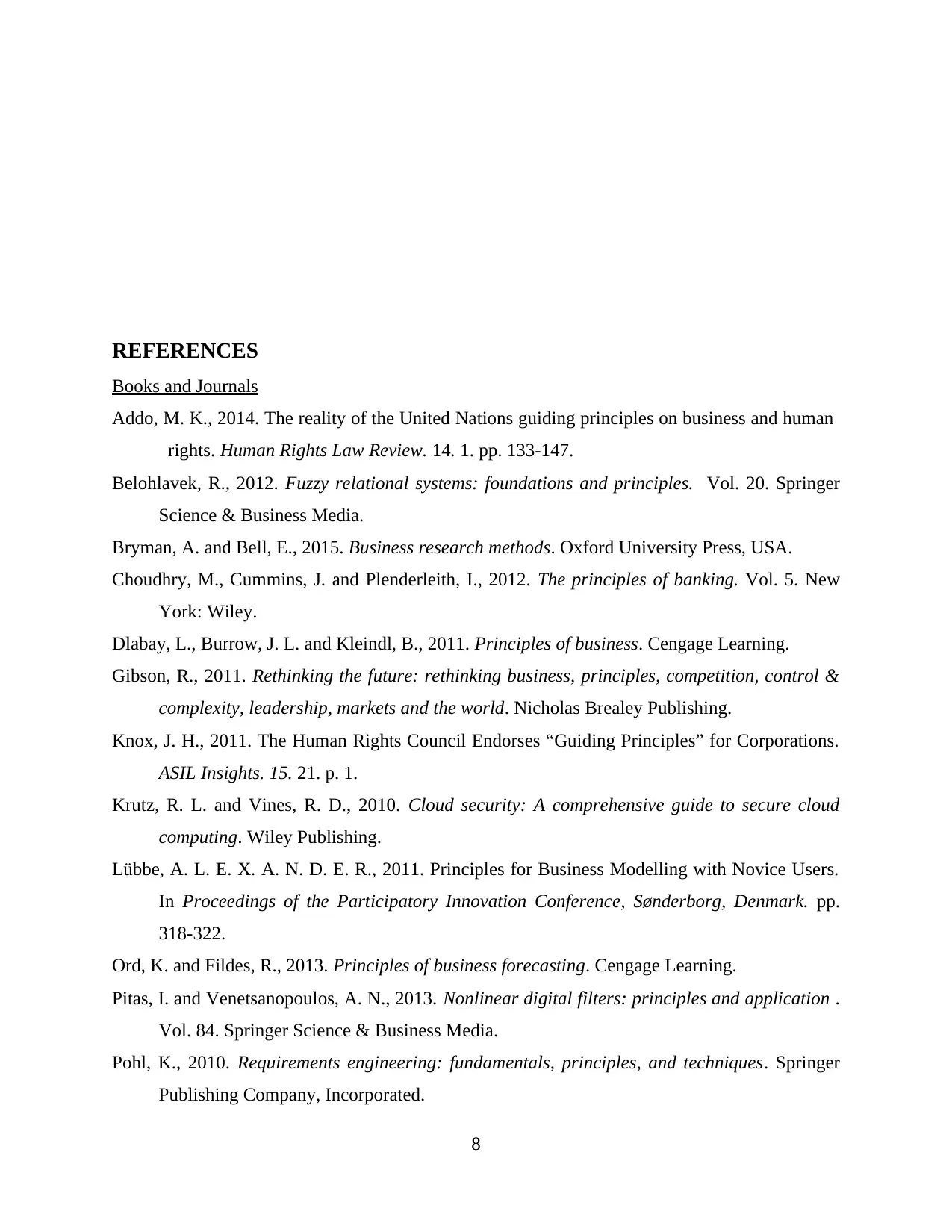
REFERENCES
Books and Journals
Addo, M. K., 2014. The reality of the United Nations guiding principles on business and human
rights. Human Rights Law Review. 14. 1. pp. 133-147.
Belohlavek, R., 2012. Fuzzy relational systems: foundations and principles. Vol. 20. Springer
Science & Business Media.
Bryman, A. and Bell, E., 2015. Business research methods. Oxford University Press, USA.
Choudhry, M., Cummins, J. and Plenderleith, I., 2012. The principles of banking. Vol. 5. New
York: Wiley.
Dlabay, L., Burrow, J. L. and Kleindl, B., 2011. Principles of business. Cengage Learning.
Gibson, R., 2011. Rethinking the future: rethinking business, principles, competition, control &
complexity, leadership, markets and the world. Nicholas Brealey Publishing.
Knox, J. H., 2011. The Human Rights Council Endorses “Guiding Principles” for Corporations.
ASIL Insights. 15. 21. p. 1.
Krutz, R. L. and Vines, R. D., 2010. Cloud security: A comprehensive guide to secure cloud
computing. Wiley Publishing.
Lübbe, A. L. E. X. A. N. D. E. R., 2011. Principles for Business Modelling with Novice Users.
In Proceedings of the Participatory Innovation Conference, Sønderborg, Denmark. pp.
318-322.
Ord, K. and Fildes, R., 2013. Principles of business forecasting. Cengage Learning.
Pitas, I. and Venetsanopoulos, A. N., 2013. Nonlinear digital filters: principles and application .
Vol. 84. Springer Science & Business Media.
Pohl, K., 2010. Requirements engineering: fundamentals, principles, and techniques. Springer
Publishing Company, Incorporated.
8
Books and Journals
Addo, M. K., 2014. The reality of the United Nations guiding principles on business and human
rights. Human Rights Law Review. 14. 1. pp. 133-147.
Belohlavek, R., 2012. Fuzzy relational systems: foundations and principles. Vol. 20. Springer
Science & Business Media.
Bryman, A. and Bell, E., 2015. Business research methods. Oxford University Press, USA.
Choudhry, M., Cummins, J. and Plenderleith, I., 2012. The principles of banking. Vol. 5. New
York: Wiley.
Dlabay, L., Burrow, J. L. and Kleindl, B., 2011. Principles of business. Cengage Learning.
Gibson, R., 2011. Rethinking the future: rethinking business, principles, competition, control &
complexity, leadership, markets and the world. Nicholas Brealey Publishing.
Knox, J. H., 2011. The Human Rights Council Endorses “Guiding Principles” for Corporations.
ASIL Insights. 15. 21. p. 1.
Krutz, R. L. and Vines, R. D., 2010. Cloud security: A comprehensive guide to secure cloud
computing. Wiley Publishing.
Lübbe, A. L. E. X. A. N. D. E. R., 2011. Principles for Business Modelling with Novice Users.
In Proceedings of the Participatory Innovation Conference, Sønderborg, Denmark. pp.
318-322.
Ord, K. and Fildes, R., 2013. Principles of business forecasting. Cengage Learning.
Pitas, I. and Venetsanopoulos, A. N., 2013. Nonlinear digital filters: principles and application .
Vol. 84. Springer Science & Business Media.
Pohl, K., 2010. Requirements engineering: fundamentals, principles, and techniques. Springer
Publishing Company, Incorporated.
8
Paraphrase This Document
Need a fresh take? Get an instant paraphrase of this document with our AI Paraphraser
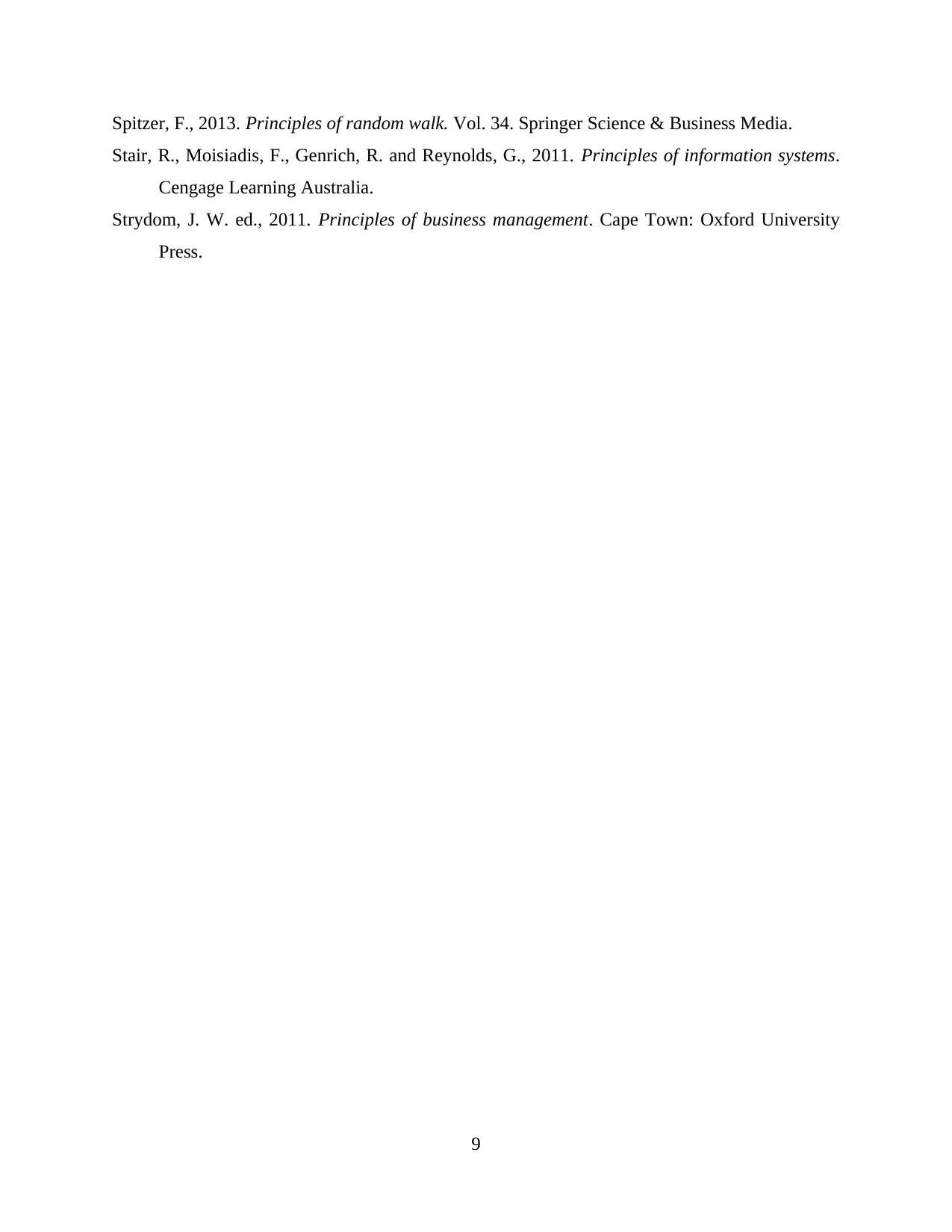
Spitzer, F., 2013. Principles of random walk. Vol. 34. Springer Science & Business Media.
Stair, R., Moisiadis, F., Genrich, R. and Reynolds, G., 2011. Principles of information systems.
Cengage Learning Australia.
Strydom, J. W. ed., 2011. Principles of business management. Cape Town: Oxford University
Press.
9
Stair, R., Moisiadis, F., Genrich, R. and Reynolds, G., 2011. Principles of information systems.
Cengage Learning Australia.
Strydom, J. W. ed., 2011. Principles of business management. Cape Town: Oxford University
Press.
9
1 out of 11
Related Documents
Your All-in-One AI-Powered Toolkit for Academic Success.
+13062052269
info@desklib.com
Available 24*7 on WhatsApp / Email
![[object Object]](/_next/static/media/star-bottom.7253800d.svg)
Unlock your academic potential
Copyright © 2020–2025 A2Z Services. All Rights Reserved. Developed and managed by ZUCOL.





